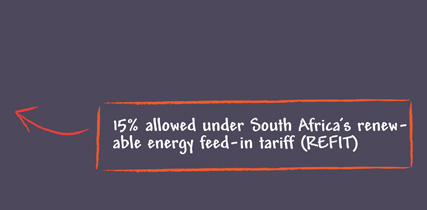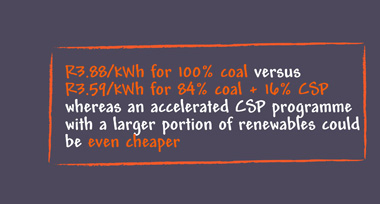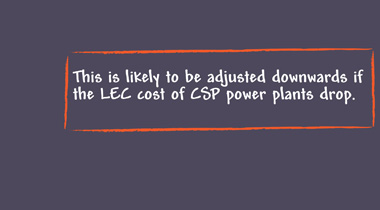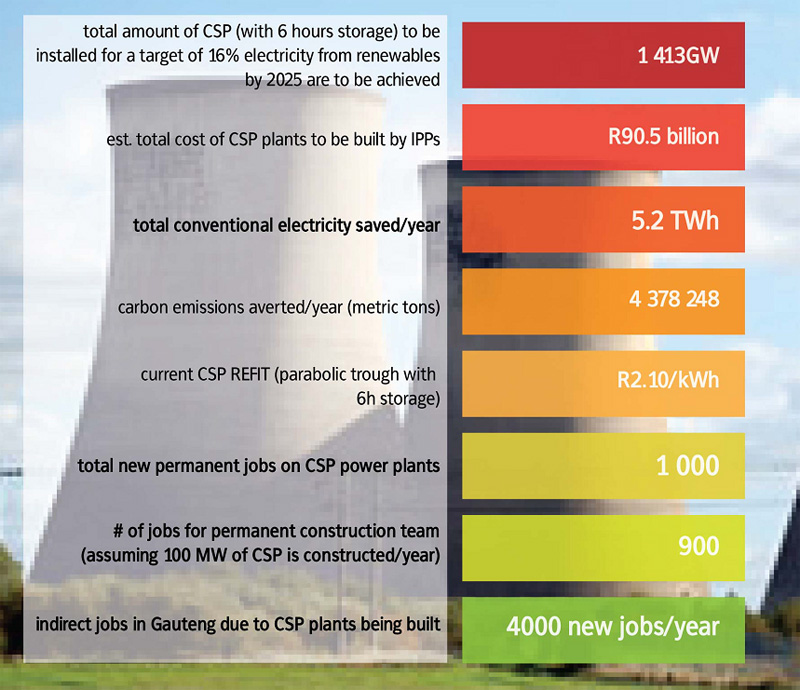
| introduction |
| background |
| role of cities |
| SA and the GCR |
| green initiatives |
| food |
| solar energy |
| energy efficiency |
| CSP |
| water and sanitation |
| waste |
| mobilising the region |
| under the magnifying glass – concentrated solar power (CSP) | |
how does it work? Concentrated solar power refers to the method of generating electricity by concentrating the sun’s power. A typical CSP plant is 50 MW or above in size. Storage of up to 7.5 full load hours has been proven commercially in Europe in the past few years. Most CSP technologies incorporate a certain percentage of backup fuel for overcast periods. Combining storage with backup fuel results in CSP becoming a dispatchable source of green electricity.
|
 |
The following figures are based on meeting the proposed 16% renewable target for Gauteng from predominantly concentrated solar power: |
|
|
|
the benefits
can this be done in Gauteng?
For Gauteng, the implementation of actual CSP plants is not as viable, due to the relatively low solar irradiation compared to other regions in South Africa. However, the energy generated with CSP from surrounding areas could be imported through the national grid into Gauteng. The electrical energy which can be generated with CSP in the southern Free State and the north-eastern Northern Cape is adequate for the Gauteng province’s demands. There are independent power producers (IPPs) who are ready to construct CSP plants under the current REFIT – and if of scale, would be prepared to manufacture such technology in South Africa. There is, however, a delay in any project progressing due to no power purchase agreements (PPAs) being issued. |
 |
DID YOU KNOW
By contrast
|
 |
However, with the escalating prices of fossil fuels and the diminishing LEC for renewables, specifically CSP, grid parity will be reached in the near future. |
|
| Grid parity is the point at which renewable electricity is equal to or cheaper than grid power. | |
| The addition of carbon tax will shorten the time to grid parity. From predicted trends grid parity for CSP in South Africa is expected by 2016 (Heun et. al., 2010). | |
| what’s the prognosis for CSP in the GCR? | |
There is huge potential for CSP in South Africa. Although Gauteng does not possess significant viable sites for CSP plants, the province has the manufacturing capabilities to have a major share in the local manufacturing of CSP plant components. Leveraging its manufacturing facilities and skills to develop a research and develpment centre and manufacturing industry around CSP over the next 15 years could lead to a new industrial sector which will require human capital ranging from basic labour to highly skilled personnel. Gauteng could also become the hub for CSP in South Africa by stimulating growth. This could be achieved with the development of specialised institutes and collaboration with local and international institutes in both the academic and commercial industries. |
|

